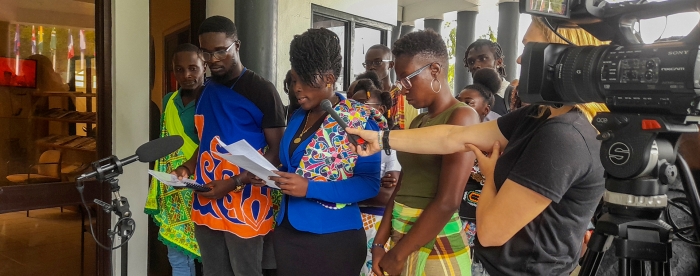News
Our stories ... ...

Suriname - 07 June, 2023
The natural forests within the territory of the Saamaka tribe in Suriname are threatened by logging and mining companies, without the consent of the Saamaka people. On 28 November 2022, a delegation of Saamaka youths went to Parliament, urging the government to expedite the processing of a law to provide the Saamaka with the legal right to their territory.
The Saamaka tribe is one of six tribal people in Suriname. Their ancestors were brought to the country from Africa as enslaved people, but managed to free themselves and establish their own communities deep within the interior rainforest. Over time, they developed a unique culture that includes customary laws and territorial boundaries. The ancestral territory in Suriname includes 74 villages located along the upper Suriname River and its tributaries, covering around 1.4 million ha, inhabited by over 25,000 people.
In the 1990s, the Suriname government began to grant industrial logging and mining concessions within the Saamaka’s tribal territory. Seeing how their natural resources were rapidly being exploited, the Saamaka initiated a case against the Suriname government at the Inter-American Court of Human Rights, arguing that their ancestral rights were being violated. On 28 November 2007 the court issued a landmark ruling stating that the Surinamese government must recognize the territorial rights of the Saamaka, as well as those of other tribes and Indigenous Peoples in the country. In response, the Suriname government has been working on a Land Rights Act for Indigenous and Tribal Communities, but it has not yet passed Parliament.
In anticipation of the new law, Tropenbos Suriname has been working with the Association of Saamaka Traditional Authorities (Vereniging van Saamaka Gezagsdragers or VSG) to prepare them for self-governance. These efforts are being coordinated by Hugo Jabini, a prominent Saamaka lawyer and the main initiator of the 2007 court case against the Suriname government. Jabini has been working closely with a group of Saamaka youths who have become active within the VSG in recent years. He brought them to more than 60 consultations in Saamaka villages. During these consultations, villagers often expressed confusion about the status of the law, given that the government was still awarding concessions located within Saamaka territory, despite the 2007 ruling.
This fuelled a sense of urgency and determination to take action among the VSG youth. They realized that the law was being stalled by the government and decided they needed to add pressure. Together with Jabini, they prepared a petition demanding the rapid consideration of the draft law and threatening new legal action if the government failed to comply. The Saamaka youth then travelled to Saamaka villages to explain the petition's content and gather signatures.
On 28 November 2022, 15 years after the court’s ruling, a delegation of Saamaka youth delivered the petition to the Chair of Parliament, in the presence of parliamentarians and government staff, as well as journalists from television, radio and newspapers. The visit received widespread media coverage. This helped to further increase pressure on the government, and within a few months the Parliament put the draft law on its agenda. After many years of stalling, the Saamaka youth’s persistence and willingness to take action resulted in the widespread recognition that the law could not be stalled any longer.
This article is part of the TBI Annual review 2022.